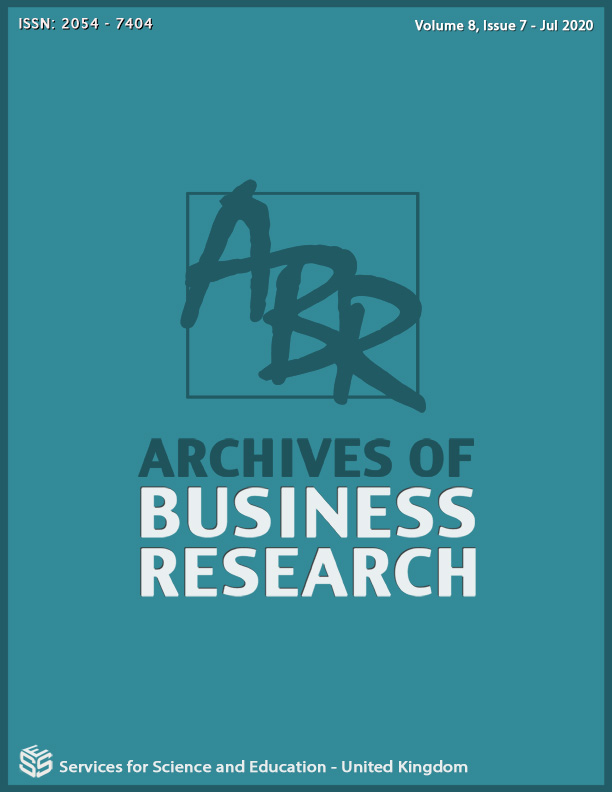7I-Model for Smart City Development
DOI:
https://doi.org/10.14738/abr.87.8615Keywords:
Smart city; Digital society; Development priorities; Modeling, 7IAbstract
The subject of the study is the development of smart cities, the effectiveness of the socio-economic systems of which is ensured by the introduction of advanced digital technologies. The research method is a logical system analysis of previous studies highlighting the development priorities of smart cities and attracting authors' results on institutional modeling of economic activity. The purpose of the study is to develop a system of sequential priorities for the development of smart cities based on institutional modeling of the stages of the formation of a digital society. As a result of the study, the author’s model of smart city development priorities is presented (the “7I” model), it is shown that the basis for the development of smart cities is the following stages: engineering infrastructure, institutes, communication and communication systems, data integration, user and technical systems interaction, innovations, application of innovation in the components of a smart city. It was determined that these stages of the development of smart cities are based on the use of advanced digital technologies and their applications: big data processing, the use of cloud technologies, digital platforms, blockchain technology, as well as shared economy, crowdsourcing, Internet of things, etc. It is concluded that the development of smart cities corresponds to the national interests of states in the formation of a digital society and ensures the safety of life in the context of the application of digital technologies.
References
[2]. Jadoul M. (2016) Smart practices for building smart cities. Elektrotechnik und Informationstechnik. Vol. 133(7), pp. 341–344.
[3]. Ingwersen P., Serrano-López A.E. (2018) Smart city research 1990–2016. Scientometrics, vol. 117(2), pp. 1205–1236.
[4]. D’Asaro, F. A., Di Gangi, M. A., Perticone, V., & Tabacchi, M. E. (2016). Computational Intelligence and Citizen Communication in the Smart City. Informatik-Spektrum, 40(1), pp. 25–34. doi:10.1007/s00287-016-1007-0
[5]. Bakici, T., Almirall, E., & Wareham, J. (2012). A Smart City Initiative: the Case of Barcelona. Journal of the Knowledge Economy, 4(2), pp. 135–148. doi:10.1007/s13132-012-0084-9
[6]. Tekinbilbil E. (2017) The Operationalizing Aspects of Smart Cities: the Case of Turkey’s Smart Strategies. Journal of the Knowledge Economy. Vol. 8(3), pp. 1032–1048.
[7]. Giatsoglou M., Chatzakou D., Gkatziaki V. et al. (2016) A Platform Prototype for Smart City Social Data Mining. Journal of the Knowledge Economy. Vol. 7(2), pp. 344–372.
[8]. Rana, N. P., Luthra, S., Mangla, S. K., Islam, R., Roderick, S., & Dwivedi, Y. K. (2018). Barriers to the Development of Smart Cities in Indian Context. Information Systems Frontiers. pp. 1-23. doi:10.1007/s10796-018-9873-4
[9]. Hollands, R. G. (2008). Will the real smart city please stand up? City, 12, pp. 303–320.
[10]. Albino, V., Umberto, B., & Dangelico, R. M. (2015). Smart cities: Definitions, dimensions, and performance. Journal of Urban Technology, 22(1), pp. 3–21.
[11]. Batty, M., Axhausen, K. W., Giannotti, F., Pozdnoukhov, A., Bazzani, A., Wachowicz, M., … Portugali, Y. (2012). Smart cities of the future. The European Physical Journal Special Topics, 214(1), pp. 481–518. doi:10.1140/epjst/e2012-01703-3
[12]. Lim, C., Kim, K.-J., & Maglio, P. P. (2018). Smart cities with big data: Reference models, challenges, and considerations. Cities. Vol. 82, pp. 86-99 doi:10.1016/j.cities.2018.04.011
[13]. Al Nuaimi, E., Al Neyadi, H., Mohamed, N., & Al-Jaroodi, J. (2015). Applications of big data to smart cities. Journal of Internet Services and Applications, 6(1). pp. 1-15. doi:10.1186/s13174-015-0041-5
[14]. Reforgiato Recupero, D., Castronovo, M., Consoli, S., Costanzo, T., Gangemi, A., Grasso, L., … Spampinato, E. (2016). An Innovative, Open, Interoperable Citizen Engagement Cloud Platform for Smart Government and Users’ Interaction. Journal of the Knowledge Economy, 7(2), pp. 388–412. doi:10.1007/s13132-016-0361-0
[15]. Bell, S., Benatti, F., Edwards, N. R., Laney, R., Morse, D. R., Piccolo, L., & Zanetti, O. (2017). Smart Cities and M3: Rapid Research, Meaningful Metrics and Co-Design. Systemic Practice and Action Research, 31(1), pp. 27–53. doi:10.1007/s11213-017-9415-x
[16]. Okwechime, E., Duncan, P., & Edgar, D. (2017). Big data and smart cities: a public sector organizational learning perspective. Information Systems and e-Business Management. pp. 1-25. doi:10.1007/s10257-017-0344-0
[17]. Hielkema, H., & Hongisto, P. (2012). Developing the Helsinki Smart City: The Role of Competitions for Open Data Applications. Journal of the Knowledge Economy, 4(2), pp. 190–204. doi:10.1007/s13132-012-0087-6
[18]. Hosseini, S., Frank, L., Fridgen, G., & Heger, S. (2018). Do Not Forget About Smart Towns. Business & Information Systems Engineering, 60(3), pp. 243–257. doi:10.1007/s12599-018-0536-2
[19]. Kitchin, R. (2013). The real-time city? Big data and smart urbanism. GeoJournal, 79(1), pp. 1-14. doi:10.1007/s10708-013-9516-8
[20]. Oueida, S., Aloqaily, M., & Ionescu, S. (2018). A smart healthcare reward model for resource allocation in smart city. Multimedia Tools and Applications. pp. 1-22. doi:10.1007/s11042-018-6647-4
[21]. Angelakis V., Tragos E., Pöhls H.C., Kapovits A., Bassi A. (2017) Designing, Developing, and Facilitating Smart Cities: Urban Design to IoT Solutions. New York: Springer. 368 p.
[22]. Lara, A. P., Moreira Da Costa, E., Furlani, T. Z., & Yigitcanlar, T. (2016). Smartness that matters: towards a comprehensive and human-centred characterisation of smart cities. Journal of Open Innovation: Technology, Market, and Complexity, 2(1), 1-13. doi:10.1186/s40852-016-0034-z
[23]. Cardullo, P., & Kitchin, R. (2018). Being a “citizen” in the smart city: up and down the scaffold of smart citizen participation in Dublin, Ireland. GeoJournal, 84, 1-13. doi:10.1007/s10708-018-9845-8
[24]. Peng, G. C. A., Nunes, M. B., & Zheng, L. (2016). Impacts of low citizen awareness and usage in smart city services: the case of London’s smart parking system. Information Systems and e-Business Management, 15(4), 845–876. doi:10.1007/s10257-016-0333-8
[25]. Yarime, M. (2017). Facilitating data-intensive approaches to innovation for sustainability: opportunities and challenges in building smart cities. Sustainability Science, 12(6), 881–885. doi:10.1007/s11625-017-0498-1
[26]. Komninos, N., & Tsarchopoulos, P. (2012). Toward Intelligent Thessaloniki: from an Agglomeration of Apps to Smart Districts. Journal of the Knowledge Economy, 4(2), 149–168. doi:10.1007/s13132-012-0085-8
[27]. Niederer, S., & Priester, R. (2016). Smart Citizens: Exploring the Tools of the Urban Bottom-Up Movement. Computer Supported Cooperative Work (CSCW), 25(2-3), 137–152. doi:10.1007/s10606-016-9249-6
[28]. Popov E.V., Semyachkov K.A. (2018) Comparative analysis of strategic aspects of the development of the digital economy. Bulletin of Perm University. Series: Economics, Vol. 13. No. 1. P. 19-36.






